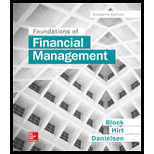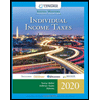
Foundations of Financial Management
16th Edition
ISBN: 9781259277160
Author: Stanley B. Block, Geoffrey A. Hirt, Bartley Danielsen
Publisher: McGraw-Hill Education
expand_more
expand_more
format_list_bulleted
Concept explainers
Question
Chapter 12, Problem 3DQ
Summary Introduction
To explain: The weakness of the payback period.
Introduction:
Pay-back period (PBP):
It is one of the methods of capital budgeting that helps evaluate the time period in which the amount of initial investment is recovered. The formula for the calculation of PBP is shown below:
Where,
Year = The year in which cumulative cash flow is near and less than the initial investment.
Initial investment = The amount of the investment.
Cumulative cash flow = The cumulative cash flow which is near and less than the initial investment.
Cash flow = The cash flow of the next year from the “Year� used for the calculation.
Expert Solution & Answer
Want to see the full answer?
Check out a sample textbook solution
Students have asked these similar questions
Company
P/S Multiples
Facebook
13.67
Snap
18.76
Twitter
13.55
Energy Resources generated an EPS of $4.38 over the last 12 months. The company's earnings are expected to grow by 30.7% next year, and because there will be
no significant change in the number of shares outstanding, EPS should grow at about the same rate. You feel the stock should trade at a P/E of around 30 times
earnings. Use the P/E approach to set a value on this stock.
Using the P/E approach, the value on this stock is $
(Round to the nearest cent.)
The Anderson Company has a net profits of $20 million, sales of $226 million, and 3.9 million shares of common stock outstanding. The company has total assets of
$139 million and total stockholders' equity of $74 million. It pays $2.31 per share in common dividends, and the stock trades at $40 per share. Given this information,
determine the following:
a. Anderson's EPS.
b. Anderson's book value per share and price-to-book-value ratio.
c. The firm's P/E ratio.
d. The company's net profit margin.
e. The stock's dividend payout ratio and its dividend yield.
f. The stock's PEG ratio, given that the company's earnings have been growing at an average annual rate of 8.2%.
a. Anderson's EPS is $
(Round to the nearest cent.)
Chapter 12 Solutions
Foundations of Financial Management
Ch. 12 - Prob. 1DQCh. 12 - Why does capital budgeting rely on analysis of...Ch. 12 - Prob. 3DQCh. 12 - Prob. 4DQCh. 12 - What does the term mutually exclusive investments...Ch. 12 - Prob. 6DQCh. 12 - If a corporation has projects that will earn more...Ch. 12 - What is the net present value profile? What three...Ch. 12 - How does an asset’s ADR (asset depreciation...Ch. 12 - Prob. 1P
Ch. 12 - Prob. 2PCh. 12 - Assume a firm has earnings before depreciation and...Ch. 12 - Assume a firm has earnings before depreciation and...Ch. 12 - Al Quick, the president of a New York Stock...Ch. 12 - Prob. 6PCh. 12 - Prob. 7PCh. 12 - Assume a 90,000 investment and the following cash...Ch. 12 - Prob. 9PCh. 12 - X-treme Vitamin Company is considering two...Ch. 12 - You buy a new piece of equipment for 16,230, and...Ch. 12 - Prob. 12PCh. 12 - Home Security Systems is analyzing the purchase of...Ch. 12 - Aerospace Dynamics will invest 110,000 in a...Ch. 12 - The Horizon Company will invest 60,000 in a...Ch. 12 - Skyline Corp. will invest 130,000 in a project...Ch. 12 - The Hudson Corporation makes an investment of ...Ch. 12 - The Pan American Bottling Co. is considering the...Ch. 12 - You are asked to evaluate the following two...Ch. 12 - Turner Video will invest 76,344 in a project. The...Ch. 12 - The Suboptimal Glass Company uses a process of...Ch. 12 - Keller Construction is considering two new...Ch. 12 - Davis Chili Company is considering an investment...Ch. 12 - Prob. 25PCh. 12 - Assume 65,000 is going to be invested in each of...Ch. 12 - The Summit Petroleum Corporation will purchase an...Ch. 12 - Oregon Forest Products will acquire new equipment...Ch. 12 - Prob. 29PCh. 12 - Prob. 30PCh. 12 - Prob. 31PCh. 12 - Prob. 32PCh. 12 - Prob. 33PCh. 12 - Prob. 2WECh. 12 - Returning to TXN’s summary page, record the...
Knowledge Booster
Learn more about
Need a deep-dive on the concept behind this application? Look no further. Learn more about this topic, finance and related others by exploring similar questions and additional content below.Similar questions
- Davis Industries must choose between a gas-powered and an electric-powered forklift truck for moving materials in its factory. Because both forklifts perform the same function, the firm will choose only one. (They are mutually exclusive investments.) The electric-powered truck will cost more, but it will be less expensive to operate; it will cost $23,000, whereas the gas-powered truck will cost $17,100. The cost of capital that applies to both investments is 11%. The life for both types of truck is estimated to be 6 years, during which time the net cash flows for the electric-powered truck will be $6,500 per year, and those for the gas-powered truck will be $4,750 per year. Annual net cash flows include depreciation expenses. Calculate the NPV and IRR for each type of truck, and decide which to recommend. Do not round intermediate calculations. Round the monetary values to the nearest dollar and percentage values to two decimal places. Electric-poweredforklift truck…arrow_forwardA project has an initial cost of $45,000, expected net cash inflows of $9,000 per year for 11 years, and a cost of capital of 14%. What is the project's NPV? (Hint: Begin by constructing a time line.) Do not round intermediate calculations. Round your answer to the nearest cent.arrow_forwardA project has an initial cost of $45,000, expected net cash inflows of $9,000 per year for 11 years, and a cost of capital of 14%. What is the project's NPV? (Hint: Begin by constructing a time line.) Do not round intermediate calculations. Round your answer to the nearest cent.arrow_forward
- image is blurr please comment i will write values then solve.Please don't solve i mistakely posted blurr image. i will give unhelpful if answer is incorrect..arrow_forwardimage is blurr please comment i will write values then solve.Please don't solve i mistakely posted blurr image. i will give unhelpful if answer is incorrect..arrow_forwardYou are thinking of inving in Tikki's Torches, Inc. You have only the following information on the at year-end 2008: Net income0.000 Total debt 12.2 million Debt ratio 42% What is Tikki's ROE for 2008? a. 1.79% b. 10.14% c. 3.09% d. 4.26%arrow_forward
- Crenshaw, Incorporated, is considering the purchase of a $367,000 computer with an economic life of five years. The computer will be fully depreciated over five years using the straight-line method. The market value of the computer will be $67,000 in five years. The computer will replace five office employees whose combined annual salaries are $112,000. The machine will also immediately lower the firm's required net working capital by $87,000. This amount of net working capital will need to be replaced once the machine is sold. The corporate tax rate is 22 percent. The appropriate discount rate is 15 percent. Calculate the NPV of this project. Note: Do not round intermediate calculations and round your answer to 2 decimal places, e.g., 32.16. NPV Answer is complete but not entirely correct. S 103,141.80arrow_forwardYour firm is contemplating the purchase of a new $610,000 computer-based order entry system. The system will be depreciated straight-line to zero over its five-year life. It will be worth $66,000 at the end of that time. You will save $240,000 before taxes per year in order processing costs, and you will be able to reduce working capital by $81,000 (this is a one-time reduction). If the tax rate is 21 percent, what is the IRR for this project? Note: Do not round intermediate calculations and enter your answer as a percent rounded to 2 decimal places, e.g., 32.16. IRR %arrow_forwardQUESTION 1 Examine the information provided below and answer the following question. (10 MARKS) The hockey stick model of start-up financing, illustrated by the diagram below, has received a lot of attention in the entrepreneurial finance literature (Cumming & Johan, 2013; Kaplan & Strömberg, 2014; Gompers & Lerner, 2020). The model is often used to describe the typical funding and growth trajectory of many startups. The model emphasizes three main stages, each of which reflects a different phase of growth, risk, and funding expectations. Entrepreneur, 3 F's Debt(banks & microfinance) Research Business angels/Angel Venture funds/Venture capitalists Merger, Acquisition Grants investors PO Public market Growth (revenue) Break even point Pide 1st round Expansion 2nd round 3rd round Research commercial idea Pre-seed Initial concept Seed Early Expansion Financial stage Late IPO Inception and prototype Figure 1. The hockey stick model of start-up financing (Lasrado & Lugmayr, 2013) REQUIRED:…arrow_forward
arrow_back_ios
SEE MORE QUESTIONS
arrow_forward_ios
Recommended textbooks for you
- Principles of Accounting Volume 2AccountingISBN:9781947172609Author:OpenStaxPublisher:OpenStax College
 Intermediate Financial Management (MindTap Course...FinanceISBN:9781337395083Author:Eugene F. Brigham, Phillip R. DavesPublisher:Cengage Learning
Intermediate Financial Management (MindTap Course...FinanceISBN:9781337395083Author:Eugene F. Brigham, Phillip R. DavesPublisher:Cengage Learning  Business/Professional Ethics Directors/Executives...AccountingISBN:9781337485913Author:BROOKSPublisher:Cengage
Business/Professional Ethics Directors/Executives...AccountingISBN:9781337485913Author:BROOKSPublisher:Cengage Individual Income TaxesAccountingISBN:9780357109731Author:HoffmanPublisher:CENGAGE LEARNING - CONSIGNMENT
Individual Income TaxesAccountingISBN:9780357109731Author:HoffmanPublisher:CENGAGE LEARNING - CONSIGNMENT

Principles of Accounting Volume 2
Accounting
ISBN:9781947172609
Author:OpenStax
Publisher:OpenStax College


Intermediate Financial Management (MindTap Course...
Finance
ISBN:9781337395083
Author:Eugene F. Brigham, Phillip R. Daves
Publisher:Cengage Learning


Business/Professional Ethics Directors/Executives...
Accounting
ISBN:9781337485913
Author:BROOKS
Publisher:Cengage

Individual Income Taxes
Accounting
ISBN:9780357109731
Author:Hoffman
Publisher:CENGAGE LEARNING - CONSIGNMENT